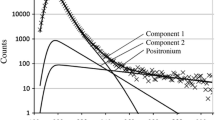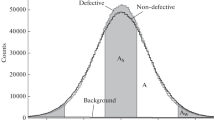Abstract
A technique for determining the sizes of vacancies and pores in metals by positron annihilation spectroscopy (PAS) in the angstrom and nanometer ranges is proposed. Following the proposed technique, the radii of vacancy-type defects in iron are estimated. The obtained results are of special interest for research programs in which properties of critical engineering materials [49–55] are studied using beams of slow positrons at positron facilities (see Research Program at the LEPTA Facility, I. Meshkov for LEPTA collaboration).
Similar content being viewed by others
References
Slugen, V., Segers, D., de Bakker, P.M.A., de Grave, E., Magula, V., van Hoecke, T., and van Waeyenberge, B., Annealing Behaviour of Reactor Pressure-Vessel Steels Studied by Positron-Annihilation Spectroscopy, Mössbauer Spectroscopy And Transmission Electron Microscopy, J. Nucl. Mater., 1999, vol. 274, no. 3, pp. 273–286.
Zeman, A., Debarberis, L., Kupča, L., Acosta, B., Kytka, M., and Degmová, A., Study of Radiation-Induced Degradation of RPV Steels and Model Alloys by Positron Annihilation and Mössbauer Spectroscopy, J. Nucl. Mater., 2007, vol. 360, no. 3, pp. 272–281.
Lambrecht, M. and Almazouzi, A., Positron Annihilation Study of Neutron Irradiated Model Alloys and of a Reactor Pressure Vessel Steel, J. Nucl. Mater., 2009, vol. 385, no. 2, pp. 334–338.
Slugeögel, G., Sperr, P., and Triftshäuser, W., Positron Annihilation Studies of Neutron Irradiated and Thermally Treated Reactor Pressure Vessel Steels, J. Nucl. Mater., 2002, vol. 302, nos. 2–3, pp. 89–95.
Sluge Positron Annihilation Studies of Neutron Irradiated and Thermally Treated Reactor Pressure Vessel Steels, NDT & E Int., 2004, vol. 37, no. 8, pp. 651–661.
Belyaev, V.N. and Metelitsin, V.V., Using of Slow Positrons in Various Investigations-State of the Art and Perspectives, Nucl. Instrum. Methods Phys. Res., Sect. A, 2000, vol. 448, nos. 1–2, pp. 89–93.
Debarberis, L., Kryukov, A., Erak, D., Kevorkyan, Yu., and Zhurko, D., Advanced Method for WWER RPV Embrittlement Assessment, Int. J. Press. Vessels Piping, 2004, vol. 81, no. 8, pp. 695–701.
Nishiyama, Y., Onizawa, K., Suzuki, M., Anderegg, J.W., Nagai, Y., Toyama, T., Hasegawa, M., and Kameda, J., Effects of Neutron-Irradiation-Induced Intergranular Phosphorus Segregation and Hardening on Embrittlement in Reactor Pressure Vessel Steels, Acta Mater., 2008, vol. 56, no. 16, pp. 4510–4521.
Egger, W., Sperr, P., Kögel, G., and Dollinger, G., Pulsed Low Energy Positron System (PLEPS) at the Munich Research Reactor FRM II. Phys. Status Solidi C, 2007, vol. 4, no. 10, pp. 3969–3972.
Grafutin, V.I. and Prokop’ev, E.P., Positron Annihilation Spectroscopy in Materials Structure Studies, Phys. Usp., 2002, vol. 45, no. 1, pp. 59–74.
Chaplygin, Yu.A., Grafutin, V.I., Svetlov-Prokopiev, E.P., and Timoshenkov, S.P., Positronics and Nanotechnologies: Possibilities of Studying Nano-Objects in Technically Important Materials and Nanomaterials, in Advances in Nanotechnology, Chen, E.J. and Peng, N., Eds., New York: Nova Sci. Publ., 2010, vol. 1, pp. 191–208.
McKenzie, S. and Totten, G.E., Analytical Characterization of Aluminum, Steel, and Superalloys, ISBN 9780824758431, 2005, pp. 667–668.
Kirkegaard, P., Pedersen, N.J., and Eldrup, M., PAT-FIT-88. Report RIS no. O-M-2740, 1989.
Grafutin, V.I., Grishkin, V.L., Myasishcheva, G.G., Funtikov, Yu.V., and Novikov, Yu. A., Positron Annihilation in Polycrystalline Metals, Phys. Solid State, 1998, vol. 40, pp. 549–551.
Grafutin, V.I., Prokop’ev, E.P., Myasishcheva, G.G., and Funtikov, Yu.V., Properties of Positron Annihilation in Metals, Phys. Solid State, 1999, vol. 41, pp. 843–847.
Prokop’ev, E.P., Grafutin, V.I., Timoshenkov, S.P., and Funtikov, Yu.V., Determination of the Size of Nanoobjects in Porous Systems and Defect Solid Bodies 1, Integral, 2008, no. 6, pp. 4–6; Determination of the Size of Nanoobjects in Porous Systems and Defect Solid Bodies 2, Integral, 2009, no. 1, pp. 10–12.
Timoshenkov, S.P., Prokop’ev, E.P., Kalugin, V.V., et al., Positronics and Nanotechnologies: Determination of the Radius of Nanoobjects in Porous Systems and Some Defect Materials by the PAS Method. I, Oboronnyi kompleks, 2008, no. 4, pp. 28–36.
Timoshenkov, S.P., Prokop’ev, E.P., Grafutin, V.I., et al., Positronics and Nanotechnologies: Determination of the Radius of Nanoobjects in Porous Systems and Some Defect Materials by the PAS Method. II, Oboronnyi kompleks, 2008, no. 4, pp. 36–43.
Grafutin, V.I., Ilyukhina, O.V., Myasishcheva, G.G., Prokopiev, E.P., Timoshenkov, S.P., Funtikov, Yu.V., and Burcl, R., Positronics and Nanotechnologies: Possibilities of Studying Nanoobjects in Materials and Nanomaterials by the Method of Positron-Annihilation Spectroscopy, Phys. At. Nucl., 2009, vol. 72, no. 10, pp. 1672–1681.
Grafutin, V.I., Prokop’ev, E.P., Timoshenkov, S.P., Evstaf’ev, S.S., and Funtikov, Yu.V., Positronics and Nanotechnologies: Possibilities of Studying Nanoobjects in Critical Engineering Materials Using Positron Annihilation Spectrometry, Russian Microelectronics, 2009, vol. 38, no. 6, pp. 418–428.
Grafutin, V.I., Ilyukhina, O.V., Myasishcheva, G.G., Prokopiev, E.P., Timoshenkov, S.P., Funtikov, Yu.V., Positronics of Nanoobjects in Porous and Defective Silicon- and Quartz-Based Systems, Ukr. Fiz. Zh., 2009, vol. 54, no. 5, pp. 443–453.
Grafutin, V.I., Prokop’ev, E.P., Timoshenkov, S.P., and Funtikov, Yu.V., Determination of nanoobject sizes in porous systems, nanomaterials, and some defective materials using the positron annihilation spectroscopy method (survey), Inorg. Mat., 2010, vol. 46, no. 14, pp. 1545–1554.
Grafutin, V.I., Grushevskii, A.V., Zaluzhnyi, A.G., et al., Determination of the Size of Nanoobjects in Some Defect and Porous Systems by the Method of Positron Annihilation, Probl. Chernoi Metallurg. Mater., 2009, no. 2, pp. 74–80.
Grafutin, V.I., Prokop’ev, E.P., Timoshenkov, S.P., and Funtikov, Yu.V., Determination of Radii of Nanoobjects in Porous Systems and Some Defective Materials by Positron Annihilation Spectroscopy, Poverkhn. Rentgen., Sinkhrotron. Neitron., 2009, no. 12, pp. 24–32.
Grafutin, V.I., Prokop’ev, E.P., Timoshenkov, S.P., and Funtikov, Yu.V., Determination of Radii of Nanoobjects in Porous Systems and Some Defective Materials by Positron Annihilation Spectroscopy, J. Surf. Investig., 2009, vol. 3, no. 6, pp. 917–925.
Burcl, R., Grafutin, V.I., Ilyukhina, O.V., Myasishcheva, G.G., Prokopiev, E.P., et al., Possibilities of Studying Nanoobjects in Porous Silicon and Silicon Substrates Irradiated with Protons by Positron Annihilation Spectroscopy, Phys. Solid State, 2010, vol. 52, no. 4, pp. 700–705.
Prokop’ev, E.P., A Simple Model of the Bound Positron State at Metal Vacancies, Radiatsionnye defekty v metallakh. Materialy 2 Vsesoyuznogo soveshchaniya (Proc. 2nd All-Union Conf. Radiation Defects in Metals), Alma-Ata, 1980, pp. 59–62.
Prokop’ev, E.P., Diffusion-Annihilation Model of Disintegration of Positron States on Spherical Defects in Metals, Pis’ma Zh. Tekh. Fiz., 2005, vol. 81, nos. 11–12, p. 680.
Puska, M.J. and Nieminen, R.M., Theory of Positrons in Solids and on Solid Surfaces, Rev. Mod. Phys., 1994, vol. 66, p. 841.
Hautojärvi, P., Pöllönen, L., Vehanen, A., and Yli-Kauppila, J., Vacancies and Carbon Impurities in α-Iron: Neutron Irradiation, J. Nucl. Mater., 1983, vol. 114, nos. 2–3, pp. 250–259.
Vehanen, A., Hautojärvi, P., Johansson, J., Yli-Kauppila, J., and Moser, P., Vacancies and Carbon Impurities in α-Iron: Electron Irradiation, Phys. Rev. B: Condens. Matter, 1982, vol. 25, pp. 762–780.
Brauer, G., Sob, M., and Kočik, J., Report ZfK-647, 1990.
Jun, Xu, Liu, C.T., Miller, M.K., and Chen, H., Nanocluster-Associated Vacancies in Nanocluster-Strengthened Ferritic Steel as Seen via Positron-Lifetime Spectroscopy, Phys. Rev. B: Condens. Matter, 2009, vol. 79, p. 020204(R).
Fu, C.L., Krěmar, M., Painter, G.S., and Chen, Xing-Qiu, Vacancy Mechanism of High Oxygen Solubility and Nucleation of Stable Oxygen-Enriched Clusters in Fe, Phys. Rev. Lett., 2007, p. 225502.
Druzhkov, A.P., Perminov, D.A., Arbuzov, V.L., Stepanova, N.N., and Pechorkina, N.L., Positron Confinement in Intermetallic Nanoparticles Embedded in Fe-Ni-Al Material, J. Phys.: Condens. Matter, 2004, vol. 16, pp. 6395–6404.
Druzhkov, A.P., Perminov, D.A., and Arbuzov, V.L., J. Phys.: Condens. Matter, 2004, vol. 16, pp. 365–377.
Jiang, Yong, Smith, J.R., and Odette, G.R., Formation of Y-Ti-O Nanoclusters in Nanostructured Ferritic Alloys: A First-Principles Study, Phys. Rev. B: Condens. Matter, 2009, vol. 79, p. 064103.
Druzhkov, A.P., Perminov, D.A., and Davletshin, A.E., The Effect of Alloying Elements on the Vacancy Defect Evolution in Electron-Irradiated Austenitic Fe-Ni Alloys Atudied by Positron Annihilation, J. Nucl. Mater., 2009, vol. 384, pp. 56–60.
Cižek, J., Bečvař, F., and Procházka, I., Three-Detector Setup for Positron-Lifetime Spectroscopy of Solids Containing 60Co Radionuclide, Nucl. Instrum. Methods Phys. Res., Sect. A, 2000, vol. 450, nos. 2–3, pp. 325–337.
Krsjak, V., et al., Application of Positron Annihilation Spectroscopy on the Ion Implantation Damaged Fe-Cr Alloys, Appl. Surf. Sci., 2008, vol. 255, no. 1, pp. 153–156.
Kočik, J., Keilová, E., Cižek, J., and Procházka, I., TEM and PAS Study of Neutron Irradiated VVER-Type RPV Steels, J. Nucl. Mater., 2003, vol. 303, no. 1, pp. 52–64.
Mori, G., Electrons around a Vacancy in Simple Metals, J. Phys. F: Met. Phys., 1977, vol. 7, no. 1, pp. L7–L14.
Sluge Reactor Steels by Positron Annihilation, Nucl. Eng. Des., 2005, vol. 235, pp. 1961–1967.
Puska, M.J. and Nieminen, R.M., Theory of Positrons in Solids and on Solid Surfaces, Rev. Mod. Phys., 1994, vol. 66, no. 3, p. 841–897.
Dannefaer, S., Defect and Oxygen in Silicon Studied by Positron, Phys. Status Solidi A, 1987, vol. 102, no. 2, pp. 481–491.
Puff, V., Dannefaer, V., Master, S., and Kerr, D.P., Defect Characteristics in Different Crystallographic Directions in Cz-Si as a Function of Doping and Annealing, Phys. Status Solidi A, 1987, vol. 102, no. 2, pp. 527–531.
Tao, S.J., Positronium Annihilation in Molecular Substances, J. Chem. Phys., 1972, vol. 56, no. 11, pp. 5499–5510.
Jean, Y.C., Positron Annihilation Spectroscopy for Chemical Analysis: A Novel Probe for Microstructural Analysis of Polymers, Microchem. J., 1990, vol. 42, pp. 72–102.
Amarendra, G., Rajaraman, R., Venugopal R.G., Nair, K.G.M., Viswanathan, B., Suzuki, R., Ohdaira, T., and Mikado, T., Identification of Open-Volume Defects in Disordered and Amorphized Si: A Depth-Resolved Positron Annihilation Study, Phys. Rev. B: Condens. Matter, 2001, vol. 63, no. 22, p. 224112.
SlugeWhat Kind of Information We Can Obtain from Positron Annihilation Spectroscopy? European Commission EUR 22468 EN-DG JRC, Institute for Energy Luxembourg: Office for Official Publications of the European Communities, 2006.
Deng, Q. and Jean, Y.C., Free-Volume Distributions of an Epoxy Polymer Probed by Positron Annihilation: Pressure Dependence, Macromolecules, 1993, vol. 26, no. 1, pp. 30–34.
Schaefer, H.-E., Investigation of Thermal Equilibrium Vacancies in Metals by Positron Annihilation, Phys. Status Solidi A, 1987, vol. 102, no. 1, pp. 47–65.
Dannefaer, S., Defect and Oxygen in Silicon Studied by Positron, Phys. Status Solidi A, 1987, vol. 102, no. 2, pp. 481–491.
Fuhs, W., Holzhauer, U., Mantl, S., Richter, F.W., and Sturm, R., Annihilation of Positrons in Electron-Irradiated Silicon Crystals, Phys. Status Solidi B, 1978, vol. 89, no. 1, pp. 69–75.
Grafutin, V.I., Mamedov, T.N., Meshkov, I.N., et al., Possibilities of Studying Porous Systems and Nanomaterials by the Method of Positron Annihilation Spectroscopy, in Yadernaya fizika i nanotekhnologii. Yaderno-fizicheskie aspekty formirovaniya, izucheniya i primeneniya nanostruktur (Nuclear Physics and Nanotechnologies. Nuclear Physics Aspects of Formation, Studying, and Application of Nanostructures), Sisakyan, A.N., Ed., Dubna: Joint Institute for Nuclear Research, 2008, pp. 223–241.
Author information
Authors and Affiliations
Corresponding author
Additional information
Original Russian Text © V.I. Grafutin, I.N. Meshkov, E.P. Prokop’ev, N.O. Khmelevskii, S.L. Yakovenko, 2011, published in Mikroelektronika, 2011, Vol. 40, No. 6, pp. 468–475.
Rights and permissions
About this article
Cite this article
Grafutin, V.I., Meshkov, I.N., Prokop’ev, E.P. et al. Determination of the size of vacancy-type defects in angstrom ranges by positron annihilation spectroscopy. Russ Microelectron 40, 428–435 (2011). https://doi.org/10.1134/S1063739711050039
Received:
Published:
Issue Date:
DOI: https://doi.org/10.1134/S1063739711050039




